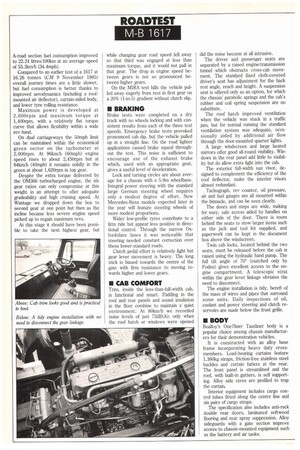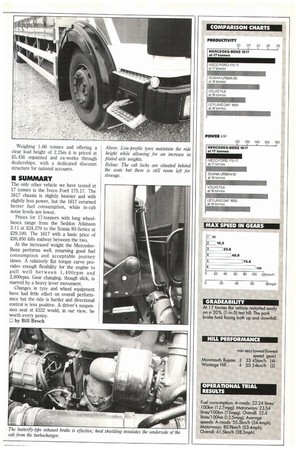• The Mercedes-Benz 1617 is only the second vehicle we
Page 32

Page 33

Page 34

Page 35

If you've noticed an error in this article please click here to report it so we can fix it.
have tested at the new 17-tonne weight limit. Unlike most other manufacturers Mercedes-Benz has chosen to retain the original designation which loosely relates to the imperial values of maximum weight and engine power.
When Mercedes-Benz first imported the 1617 (in 1976) it came equipped with an eight-speed synchromesh range-change gearbox matched to a turbocharged 5.68litre six-cylinder OM 352A engine rated at 125kW (168hp). By the end of 1984 both engine and gearbox had been changed. The slightly larger OM 366A power unit is turbocharged, giving an almost identical power output but with significantly more torque, being rated at 560Nm, driving via a lighter, cheaper six-speed gearbox.
To enable the model to operate at the new weight, heavier-duty wheels and tyres have been specified. For the haulage models 295-80RX 22.5 low-profile tyres are fitted, maintaining the same ride height as before. This has allowed axle ratings to be revised. At the front the uprated tyre and wheel equipment gives a 600kg increase to 6.7 tonnes. At the rear the design rating has been increased to 11 tonnes, but this is limited by UK legislation to operation at a maximum of 10.5 tonnes.
The 6.7 and 10.5-tonne plated weights allow a 200kg load-distribution tolerance.
;In Our test vehicle came with a 5.9m wheelbase (the longest of the three available) and is equipped with a 7.42m BoaBoy
One7liner Tautliner curtain-sided body which weighs only 1.66 tonnes. This helps achieve the desired payload of 10 imperial tons, but the 1617 falls just short of this target when allowance is made for the driver and a full tank of fuel.
III PERFORMANCE
In ideal weather conditions we started from cold on the initial motorway section of our test route and recorded a creditable 23.54 litres/100km along 103.1km of the M4 to Aust services. While unable to maintain the maximum legal speed up the steeper hills, road speed rarely dropped below 75km/h to give an average of 85.9krn/h (53.4mph).
Over the often hilly and much slower A-road section fuel consumption improved to 22.24 litres/100km at an average speed of 55.31unth (34.4mph).
Compared to an earlier test of a 1617 at 16.26 tonnes (CM 9 November 1985) overall journey times are a little slower, but fuel consumption is better thanks to improved aerodynamics (including a roofmounted air deflector), curtain-sided body, and lower tyre rolling resistance.
Maximum power is developed at 2,600rpm and maximum torque at 1,400rpm, with a relatively flat torque curve that allows flexibility within a wide rev band.
On dual carriageways the 50mph limit can be maintained within the economical green sector on the tachometer at 2,000rpm. At 96km/h (60mph) engine speed rises to about 2,450rpm but at 64km/h (40mph) it remains solidly in the green at about 1,620rpm in top gear.
Despite the extra torque delivered by the 0M366 turbocharged engine, the six gear ratios can only compromise at this weight in an attempt to offer adequate gradeability and high cruising speed. At Wantage we dropped down the box to second gear at one point but then as the incline became less severe engine speed picked up to regain maximum revs.
At this stage it should have been possible to take the next highest gear, but while changing gear road speed fell away so that third was engaged at less than maximum torque, and it would not pull in that gear. The drop in engine speed between gears is not so pronounced between higher gears.
On the MIRA test hills the vehicle pulled away eagerly from rest in first gear on a 20% (1-in-5) gradient without clutch slip.
• BRAKING
Brake tests were completed on a dry track with no wheels locking and with consistent results from each of the three test speeds. Emergency brake tests provoked pronounced cab dip, but the vehicle pulled up in a straight line. On the road lighter applications caused brake squeal throughout the test. This noise is sufficient to encourage use of the exhaust brake which, used with an appropriate gear, gives a useful level of deceleration.
Lock and turning circles are about average for a chassis with a 5.9m wheelbase. Integral power steering with the standard large German steering wheel requires only a modest degree of effort. New Mercedes-Benz models expected later in the year will feature steering wheels of more modest proportions.
Wider low-profile tyres contribute to a firm ride but appear less positive in directional control. Through the narrow Oxfordshire lanes it was noticeable that steering needed constant correction over these lower-standard roads.
Clutch pedal effort is relatively light but gear lever movement is heavy. The long stick is biased towards the centre of the gate with firm resistance to moving towards higher and lower gears.
• CAB COMFORT
Trim, inside the less-than-full-width cab, is functional and smart. Padding in the roof and rear panels and sound insulation in the floor combine to maintain a quiet environment. At 80km/h we recorded noise levels of just 72dB(A): only when the roof hatch or windows were opened did the noise become at all intrusive.
The driver and passenger seats are separated by a raised engine/transmission tunnel which obstructs cross-cab movement. The standard fixed cloth-covered driver's seat has adjustment for the back rest angle, reach and height. A suspension seat is offered only as an option, for which the chassis' parabolic springs and the cab's rubber and coil spring suspension are no substitute.
The roof hatch improved ventilation when the vehicle was stuck in a traffic jam, but for normal running the standard ventilation system was adequate, occasionally aided by additional air flow through the door-mounted quarter lights.
A large windscreen and large heated mirrors offer good all-round visibility. Windows in the rear panel add little to visibility but do allow extra light into the cab.
The exterior full-width sun visor, designed to complement the efficiency of the roof deflector, make the interior visors almost redundant.
Tachograph, rev counter, oil pressure, air and fuel gauges are all mounted within the binnacle, and can be seen clearly.
The doors and steps are wide, making for easy, safe access aided by handles on either side of the door. There is room behind the seats to stow larger items such as the jack and tool kit supplied, and paperwork can be kept in the document box above the windscreen.
Twin cab locks, located behind the two seats, must be released before the cab is raised using the hydraulic hand pump. The full tilt angle of 70° (matched only by Foden) gives excellent access to the engine compartment. A telescopic strut within the gear lever linkage obviates the need to disconnect.
The engine installation is tidy, bereft of the mass of wires and pipes that surround some units. Daily inspections of oil, coolant and power steering and clutch reservoirs are made below the front grille.
• BODY
Boalloy's One7liner Tautliner body is a popular choice among chassis manufacturers for their demonstration vehicles.
It is constructed with an alloy base frame incorporating heavy duty crossmembers. Load-bearing curtains feature 1,360kg straps, friction-free stainless steel buckles and curtain furlers at the rear. The front panel is streamlined and the roof, with built-in gutters, is self supporting. Alloy side raves are profiled to trap the curtain.
Interior equipment includes cargo control tubes fitted along the centre line and six pairs of cargo straps.
The specification also includes anti-rack double rear doors, laminated softwood flooring and rear spray suppression. Alloy sideguards with a gate section improve access to chassis-mounted equipment such as the battery and air tanks. Weighing 1.66 tonnes and offering a clear load height of 2.25m it is priced at £5,456 unpainted and ex-works through dealerships, with a dedicated discount structure for national accounts.
• SUMMARY
The only other vehicle we have tested at 17 tonnes is the Iveco Ford 175.17. The 1617 chassis is slightly heavier and with slightly less power, but the 1617 returned better fuel consumption, while in-cab noise levels are lower.
Prices for 17-tonners with long wheelbases range from the Seddon Atkinson 2-11 at £24,270 to the Scania 93-Series at £29,100. The 1617 with a basic price of £26,850 falls midway between the two.
At the increased weight the MercedesBenz performs well, returning good fuel consumption and acceptable journey times. A relatively flat torque curve provides enough flexibility for the engine to pull well between 1,4 0Orpm and 2,600rpm. Gear changing, though slick, is marred by a heavy lever movement.
Changes in tyre and wheel equipment have had little effect on overall performance but the ride is harder and directional control is less positive. A driver's suspension seat at £332 would, in our view, be worth every penny.
CI by Bill Brock
Above: Low-profile tyres maintain the ride height while allowing for an increase in plated axle weights.
Below: The cab locks are situated behind the seats but there is still room left for stowage.
































































































